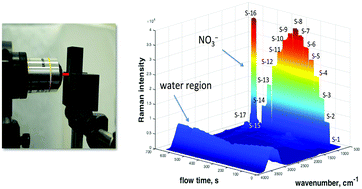Development and testing of a novel micro-Raman probe and application of calibration method for the quantitative analysis of microfluidic nitric acid streams†
Abstract
To simplify and improve the safety of reprocessing used nuclear fuel, an initial assessment was made of Raman microscopy applied to microfluidic volumes with a view toward the on-line spectroscopic measurement of highly radioactive solutions. This study compares a microscopic Raman probe (excitation focal point diameter 70 μm) to a larger, well studied probe (excitation focal point diameter 125 μm) used in prior investigations. This was done by chemometrically modeling and predicting concentrations of HNO3 solutions (0 M to 8 M) as they flowed through microfluidic cells based upon spectra from each probe. Spectra recorded for each probe using the same static HNO3 solution set contained in 2 dram glass vials were used as training sets to produce models for the respective probes. Modeling required baseline, normalization and smoothing preprocessing to compensate for a reduced path length between the static glass vial training set (4 cm) and the reduced path length flow cell (1 cm), wide ranging solution concentrations, and the associated non-linear spectral changes, and abrupt and uneven concentration changes of flowing solutions. The micro-Raman probe is able to produce spectra that may be analyzed chemometrically to accurately predict the concentration of flowing HNO3 solutions down to microliter volumes. Based upon RMSECV and RMSEP modeling statistics concentration predictions of the micro-Raman probe are comparable to those obtained for a macro-Raman on identical samples.



 Please wait while we load your content...
Please wait while we load your content...